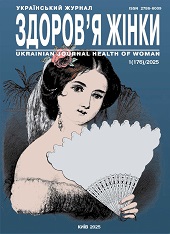Сhorioamnionitis and preterm birth: a retrospective study
DOI:
https://doi.org/10.15574/HW.2025.1(176).4548Keywords:
preterm birth, chorioamnionitis, subclinical chorioamnionitis, histology, pregnancy, womenAbstract
Aim - to determine the frequency of clinical (CCA) and subclinical (histological) chorioamnionitis (SCA) in patients with preterm birth (PTB) and to analyze their association with gestational age and pregnancy outcomes, in order to improve early diagnosis, risk stratification, and prevention of PTB associated with intraamniotic inflammation.
Materials and methods. This retrospective study included cases of PTB from 2022 to 2024. A total of 15,760 charts of pregnant women were analyzed, from which 562 (3.5%) cases with PTB were identified (out of 562, 210 (37%) pregnant women were diagnosed with SCA). Patients were divided into three groups based on gestational age: the Group 1 (22-27 weeks) - 42 patients, the Group 2 (28-34 weeks) - 187 patients and the Group 3 (35-37 weeks) - 333 patients. The presence of chorioamnionitis was determined based on histological and clinical data. The study analyzed the structure and causes of PTB as well as birth outcomes.
Results. A significant association was found between SCA and PTB, particularly in the early gestational group (22-27 weeks), where SCA was present in 73% of cases.
Conclusions. SCA is a common and important cause of PTB, especially at earlier gestational ages. It is mainly diagnosed through histological examination of the placenta. A strong association exists between SCA and adverse labor outcomes. A multifactorial approach is required for the prediction and prevention of PTB related to intraamniotic inflammation.
No conflict of interests was declared by the authors.
References
Fettweis JM, Serrano MG, Brooks JP. (2022). The vaginal microbiome and preterm birth. Nat Med. 28(4): 674-684. https://doi.org/10.1038/s41591-019-0450-2; PMid:31142849 PMCid:PMC6750801.
Goldenberg RL, Culhane JF, Gravett MG. (2021). Epidemiology and causes of preterm birth. Lancet. 398(10304): 1434-1444.
Kim CJ, Romero R, Chaemsaithong P et al. (2021). The frequency, clinical significance, and pathological features of chronic chorioamnionitis. Mod Pathol. 34(5): 904-915.
Menon R, Jones NM, Fortunato SJ. (2023). Intraamniotic infection and inflammation: a complex mechanism of preterm birth. Reprod Sci. 30(1): 12-24.
Romero R, Dey SK, Fisher SJ. (2022). Infection and labor: the role of the immune system at the maternal-fetal interface. Am J Obstet Gynecol. 226(2): S117-S130.
Romero R, Miranda J, Chaiworapongsa T et al. (2021). A novel molecular microbiologic technique for the rapid diagnosis of intra-amniotic infection. Am J Obstet Gynecol. 225(1): 94.e1-94.e23.
Downloads
Published
Issue
Section
License
Copyright (c) 2025 Ukrainian Journal Health of Woman

This work is licensed under a Creative Commons Attribution-NonCommercial 4.0 International License.
The policy of the Journal UKRAINIAN JOURNAL «HEALTH OF WOMAN» is compatible with the vast majority of funders' of open access and self-archiving policies. The journal provides immediate open access route being convinced that everyone – not only scientists - can benefit from research results, and publishes articles exclusively under open access distribution, with a Creative Commons Attribution-Noncommercial 4.0 international license (СС BY-NC).
Authors transfer the copyright to the Journal UKRAINIAN JOURNAL «HEALTH OF WOMAN» when the manuscript is accepted for publication. Authors declare that this manuscript has not been published nor is under simultaneous consideration for publication elsewhere. After publication, the articles become freely available on-line to the public.
Readers have the right to use, distribute, and reproduce articles in any medium, provided the articles and the journal are properly cited.
The use of published materials for commercial purposes is strongly prohibited.

